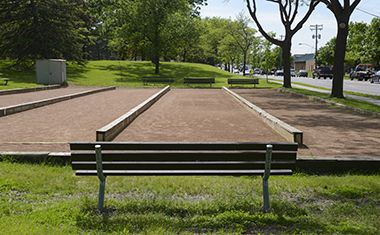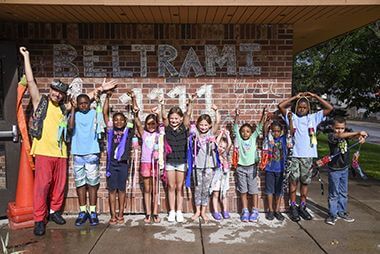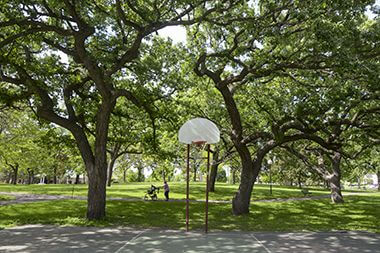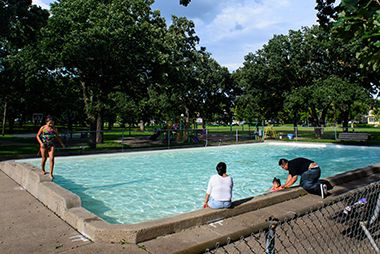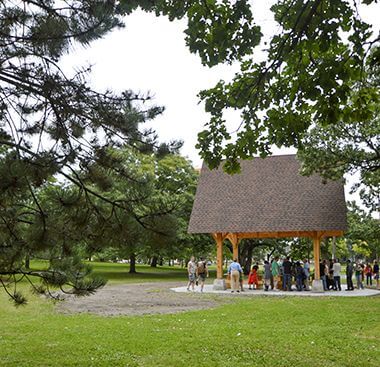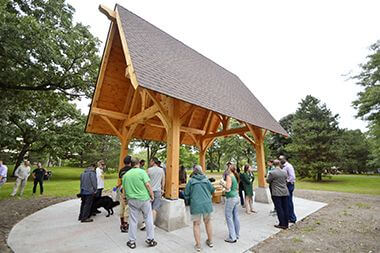Address
1111 Summer St. NE
Minneapolis, MN 55413
Plan Your Route
Contact
General: 612-230-6400
Email: info@minneapolisparks.org
Wading Pool Information
Features & Amenities
- Basketball Court
- Bocce Ball Court
- Drinking Fountain
- Grill
- Little Free Library
- Picnic Area
- Playground/Tot Lot
- Restroom Facility
- Soccer Field
- Softball Field
- Volleyball Court – Sand
- Wading Pool
- Walking Path
Not finding what you’re looking for?
Search Parks & Destinations
Park Projects
See what’s currently in the works for this park. Some projects may be under the name of the regional park or service area it lives within. View Current Projects

Your NPP20 money at work:
Maintenance is increasing at all neighborhood parks, thanks to additional annual funding from the 20-Year Neighborhood Park Plan (NPP20). This initiative also funds ongoing rehabilitation and major project to restore neighborhood parks and help address racial and economic equity.
Park Details
Rentals & Permits
Outdoor Use and Event Space: Learn how to reserve park space for corporate events, community celebrations, and more.
History
Name: The park was called Maple Hill from 1908 to 1948. It was the known as Maple Hill Cemetery prior to that and when the park board acquired the land it kept the name. In 1947, the park was renamed for Giacomo Constantino Beltrami an Italian explorer who is credited with being the first European to identify the source of the Mississippi River in Minnesota in 1823. The park was renamed at the request of the predominantly Italian-American residents in the neighborhood that surrounded the park. A bronze plaque honoring Beltrami, which still stands, was placed in the park in 1948. It was paid for by contributions from Minneapolis residents of Italian descent.
Acquisition and Development
The park was purchased for $8,000 in 1908. Under the financing terms, the city council had to approve the purchase, which it did. The city council contributed $5,000 for the initial improvement of the land as well.
Initial improvements consisted primarily of constructing a seven-foot high wire mesh fence around the cemetery to protect the Civil War-era stone monuments from vandalism. Some of the monuments and interred remains were moved to other cemeteries. The fence remained until 1922 when area residents complained of the “unsightly” fence. The park board determined that it was too expensive to repair, so tore it down.
The conversion of a cemetery to a park did not meet with universal approval. A monument still stands in Beltrami Park that honors the 46 soldiers of the “Grand Army of the Republic” who were buried there during and after the Civil War. The inscription on the undated tablet reads in part, “Although men’s thoughtless actions have deprived them of their right to individually marked and cherished graves, the children of future ages will gather here to honor them.” The date of the monument is not noted. (The quartermaster at Fort Snelling requested permission in 1939 to remove from the park the remains of Civil War veterans for re-interment at Fort Snelling.)
In the first plans for Maple Hill Park, presented in the 1908 superintendent’s report, Theodore Wirth proposed a picnic ground for most of the park, with a small section—where no bodies had been buried—reserved for a school garden for the children of Pierce School across the street from the park. (Before cities began building urban parks in the mid-1800s, cemeteries were used as picnic grounds throughout the country.) Wirth also proposed a small shelter building that the 1909 annual report says was used as a warming house, indicating that Maple Hill was provided a skating rink. However, park board proceedings note that area residents petitioned for a skating rink in both 1911 and 1912 and that the park board finally granted those requests in 1913.The shelter was also for “lectures” and a tool room. Wirth noted in his 1909 report that the park was not much frequented and probably wouldn’t be as long as it “retains the appearance of a cemetery.”
After the construction of a fieldhouse with indoor plumbing at nearby Logan Park in 1912, two toilets were moved from Logan to Beltrami in 1914. A couple years later a small set of playground equipment was also installed in the park. To satisfy a petition from area residents, in 1918 Beltrami got more than toilets from nearby Logan Park: two of the free summer outdoor concerts scheduled for Logan were transferred to Beltrami.
Wirth presented a more detailed plan for the improvement of the park in 1921—including a more permanent shelter building—noting that “the growing activities of this field can hardly be denied the needed extension of facilities.” In fact the neighborhood was denied, because Wirth presented the same plan again in 1935, indicating there had been little improvement of the park in intervening years. The 1935 plan was not acted upon either.
One of Beltrami’s claims to fame was that the skating club at the park produced Minneapolis’s first qualifier for a U. S. Winter Olympic team. Charles Leighton of the Maple Hill Club qualified to represent the U.S. in speed skating, but never got the chance at a medal. The 1940 winter games scheduled for Sapporo, Japan were cancelled because of World War II. By the mid-1940s Beltrami Park’s skating rink was maintained without a warming house.
Although residents had petitioned for a tennis court as early as 1915 and were still doing so twenty years later, there is no record of when the tennis court that currently exists at Beltrami was installed. The enormous oak tree branch that stretches over the court, removing the lob from the arsenal of shots Beltrami tennis players could use, suggests it has existed at least since the first concrete wading pool was built in the park in 1953.
Beltrami finally got a more modern recreation center during the expansion of park recreation facilities in the 1970s. The current small shelter was dedicated in 1973. Although it is not currently considered a fully-staffed recreation center, it does host neighborhood meetings, childcare groups, and summer activities.
Beltrami is one of the only places in Minneapolis for a game of bocce ball on specially constructed courts. Six bocce courts in the park, the most recent of which were added in 1990, continue to be used for games every Tuesday night in summer.
The basketball court was resurfaced with new hoops in 2015. In 2016, a new timber frame picnic pavilion was built near the basketball court.
Trivia
In 1911 the park board joined residents of the Maple Hill area in opposing construction of a gas manufacturing plant across from the park.
History through 2008 written by David C. Smith, with updates from 2009 to present written by MPRB.








